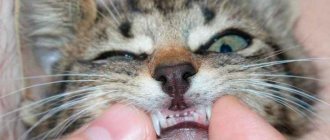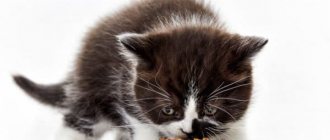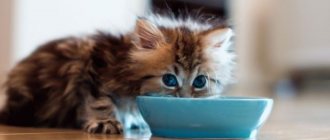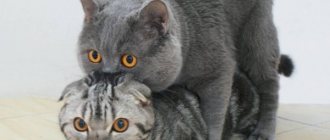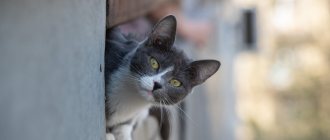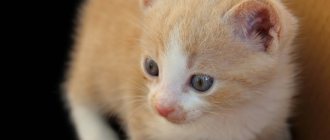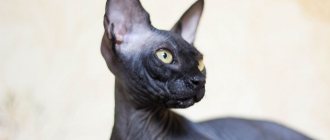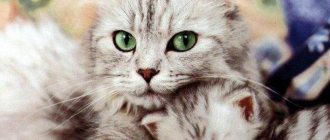The size and physiological maturation of animals depend on a large number of different factors. To know exactly to what age cats grow, it is necessary to take into account their breed, the functioning of the endocrine glands and their general health. Proper care and the creation of suitable conditions can affect the growth of a pet.
How old do cats grow?
Height in cats is a relative concept. With age, they may become larger in both length and width, depending on the breed. And not only this affects the growth rate of a pet. Physical activity, diet, and general health all play a role here. Of course, there are average indicators that can be used to roughly determine at what age a pet will reach its maximum size. But they are different for each breed.
Scots
Among the Scots, one can distinguish lop-eared and straight-eared representatives. If we look at the general characteristics of the breed, we can see that by the age of three, cats’ muscle mass, skeleton, as well as eye color and coat color are finally formed.
Fold
Scottish Fold kittens are born weighing from 60 to 140 grams. It all depends on the number of brothers and sisters. In the first two weeks, the weight gain will be small and will not exceed 20 grams. In the future, growth will go faster, the main thing is to ensure that the kitten receives a sufficient amount of mother's milk. By two months, his weight should reach 1.5 kg, and by six months, up to 3 kg.
Scottish Folds develop to their maximum by the age of three. The weight of an adult male can reach 6.5 kg, and females 4.5 kg. By that time, they are already fully physically developed and ready to reproduce.
Straight-eared
Representatives of straight-eared Scots are somewhat larger than their fold-eared counterparts. Their growth rates are not much different, but their final weight is yes. Males by the time of their final development reach 7 kg in weight, while females can weigh 6 kg. This is due not only to nutrition. Genetics plays a big role here. Straight-eared Scots rarely have deviations in terms of height. And if the cat is also a purebred, then we can safely say that he will grow into a fat teddy.
British
The British begin to actively grow already at the age of one month. By then, their teeth have formed and they can eat on their own. Since, due to the characteristics of the breed, these felines are prone to obesity, their diet should be given increased attention.
Their musculoskeletal mass is finally formed by 2-2.5 years of life. But even after this they can continue to develop, until they reach the age of three. The weight of an adult male can reach 8 kg, and a female 6 kg. If you add two kilograms to each indicator, you can get the weight that these representatives of the feline family can gain after castration or sterilization.
Regular cats
Cats and male cats without claims to purebred also have their own developmental characteristics. As a rule, they reach the bulk and growth by two years. As mentioned earlier, a lot depends on heredity, nutrition and lifestyle. Sedentary animals that prefer to spend most of their time lying on the sofa can reach a weight of up to 9 kg. Moreover, these can be both males and females. Especially when it comes to castrated or sterilized cats.
In the latter case, special attention must be paid to nutrition. It will be better if you feed the animal with special dietary foods that have a balanced combination of nutritional components and are easily absorbed by the body.
Maine Coon
There is a misconception that adult Maine Coons can reach up to 15 and even 25 kg in weight. However, despite the large growth (up to 100 cm in length) of the animal, the weight of an adult male does not exceed 12 kg, and the female is even less - 8 kg. They are born larger than kittens of other breeds: babies can weigh from 120 to 140 grams. And this only happens if there are several kittens in the litter. If the baby was born alone, his weight may be 160 grams.
Maine Coons grow up to three years old, like most purebred cats. Closer to this age, their muscles actively develop: their chest becomes wider, and their shoulders and paws become stronger.
Bengal
Bengal babies weigh from 70 to 120 grams at birth. They grow actively until 9 months, after which the rate of their development decreases. In females at this age it can generally stop, while males can grow up to two years.
The maximum weight of females does not exceed 5 kg, males - 8 kg. And the body length can vary from 50 cm to 1 meter.
Sphinxes
Sphynx kittens are born tiny and helpless. Their birth weight is only 85 grams. But at the same time, after three days they are able to independently find their mother’s nipple and, with the movement of their paws, cause the release of milk. Sphynx cats are considered one of the smartest cats.
Tips for maintaining normal weight
To keep a British cat's weight within normal limits, owners need to maintain a balanced diet:
- add a small percentage of cereals and vegetables to dry and soft food;
- add boiled vegetables to the food (various varieties of cabbage, beets);
- meat and fish should only be lean, they should be included in the menu daily;
- Among the cereal products, it is best to give your cat oatmeal, millet, and rice;
- You need to cook porridge for your pet in water, without adding sugar and salt.
A kitten is taught to eat cereals and vegetables from an early age. The diet of an adult British cat should consist of 10–15% vegetables and cereals, 85–90% meat and fish.
Also, we must not forget about regular physical activity. To prevent a cat from developing obesity, the owner must engage it in active games every day.
High-quality and balanced nutrition, an abundance of vitamins and nutrients, an active lifestyle - these are the main factors for the full development of a British pet.
The owner should weigh the kitten at the same time every day in order to notice weight deviations in time. If the development of the “British” does not correspond to his age, then there is no need to hesitate in going to the veterinarian.
Many owners of purebred cats pay a lot of attention to the health of their pets. The weight of a British kitten is an important indicator of the healthy development of representatives of this breed, which is why owners are interested in what weight is considered normal for a particular cat breed.
To what age do domestic cats and cats of different breeds grow?
The size and physiological maturation of animals depend on a large number of different factors. To know exactly to what age cats grow, it is necessary to take into account their breed, the functioning of the endocrine glands and their general health. Proper care and the creation of suitable conditions can affect the growth of a pet.
Age at which cats grow
Full physiological maturation of the animal occurs with puberty. However, growth continues for some time. The average age at which cats stop growing is from 1 to 3 years. The exact time depends on several internal and external factors, including the characteristics of the content and breed. Height does not include obesity.
There are 5 stages of cat maturation:
- Neonatal - from birth to 4 days. At this time, the kitten’s weight either increases or decreases.
- Suction - from 5 days to 1 month. The animal is actively growing and developing.
- Transitional - from 1 to 1.5 months. During this period, growth slows down somewhat. New products are being introduced to the pet's menu.
- Adolescence - from 4 months to 1 year, when growth is activated again and continues until full puberty, that is, readiness for reproduction.
Starting from 1 year, the cat is considered independent.
Factors affecting dimensions
The growth and maturation of a cat is influenced by external factors and features of physiological development. These include:
- Breed is one of the most important factors affecting the height and weight of an adult animal, as well as the age at which it reaches adulthood. In outbred domestic cats, the genotype is most often mixed, so it is unlikely that it will be possible to determine the exact timing of development. Some kittens grow up to 3 years old, while others reach their maximum height and weight by one year.
- Heredity - the size of an animal largely depends on the size of its parents. It is extremely rare for small cats to give birth to large kittens.
- Gender of the animal - males always grow larger and heavier than females.
- Living conditions - growth is influenced by a comfortable room temperature, sufficient light, good restful sleep and the baby’s nutrition.
- State of health and presence of any diseases. The pathology can be any - somatic, infectious, parasitic or genetically determined. The correct functioning of the endocrine glands is also important.
- Physical activity and lifestyle - the more a kitten moves and plays, the better it grows. His body develops proportionally, and his weight is normal for his age and breed.
- Castration, especially performed in adulthood. Cats that are sterilized at the age of 2-3 years and older grow larger than those that were neutered before a year or were not sterilized at all.
Early mating before the age of 1 year leads to a slowdown or complete cessation of the animal’s growth.
Skin diseases
Unfortunately, Scottish cats are susceptible to skin diseases. A large number of varieties of diseases are difficult for the owner to diagnose independently, without veterinary experience. Symptoms are similar to allergies, scabies, eczema and demodicosis.
Based on typical signs of occurrence and development, skin diseases in the Scottish breed can be classified into three characteristic groups:
Attention! Infectious skin diseases of animals are contagious not only to animals, but also to humans. When caring for a pet, it is necessary to observe hygienic and sanitary rules and isolate the Scotsman from other brothers.
All skin diseases are pathogenic in nature and cause attacks of aggression in the pet:
Skin diseases harm the health of pets, and if urgent measures are not taken and professional treatment is not provided to the pet, the animal may die.
Hanging belly
When a cat has hanging skin on its stomach, this is not a pathology, but a genetic formation, which has the scientific term “primordial sac”. Popularly called fat tail, it is a natural property of wild felines. The Scottish cat breed has a hanging pedigree or rudimentary fold. In short-haired Scottish Straight and Scottish Fold cats, when the cat's belly hangs, it is more noticeable than in long-haired Highland Straight and Highland Fold cats.
The skin fold has a plumb line of 3-5 cm and stretches along the lower abdomen from the stomach to the paws. There is no scientific explanation for this feline feature yet.
Growths on the paws
This is a genetic pathology of Scottish Fold cats. The growths appear as a result of osteochondrodysplasia, which begins to appear in the early stages of development, so all owners need to monitor the condition of the pet’s limbs. At the first signs of the appearance of growths on the limbs, contact a veterinary clinic, where your pet will be examined. This disease cannot be cured, but prescribed medications will stop the further development of the disease and relieve acute attacks of pain in a sick pet.
Causes of delayed development
It often happens that a cat lags behind the growth standards inherent in its age and breed. There are several reasons for this phenomenon:
- Wrong diet. If a kitten’s menu lacks vitamins, protein and microelements, the animal will gain weight poorly and lag behind in physiological development.
- Diseases - these can be bacterial and viral infections, autoimmune and hereditary conditions.
- Congenital or acquired hormonal disorders. The most common cause of slow growth is sterilization too early. This operation leads to a change in the hormonal background of the animal, and, as a result, to a change in metabolism. Gradually the animal's condition is restored, but this takes more time. Other endocrine causes may include adrenal or thyroid disease.
- Helminthiasis is infection by parasites. If worms or other parasites appear in the animal's intestines, they deprive the kitten of a significant part of its nutrients. As a result, growth and development slows down.
- Prolonged stay at low ambient temperatures. It has been noticed that in the cold season pets grow more slowly. The optimal air temperature for good development is 22...25 °C.
Dependence on breed
The age at which a cat grows largely depends on the breed .
British cats are especially popular among pet lovers. This breed is distinguished by a short, bluish-gray coat that resembles a plush one. The expression on their faces can be very funny, and their disposition can be light and affectionate.
Females of this breed gain weight up to 6 kg, and after sterilization they can grow up to 8 kg. An adult British cat gains up to 8 kg of body weight, and after castration, up to 10 kg. The age at which British cats grow is 3 years; in female cats, maturation occurs faster - by 1.5 years. If pregnancy occurs, growth is interrupted during this time, but then the female makes up for the lack of weight.
The Scots have growth parameters and development periods that coincide with the British. But Scottish kittens have a more balanced character.
In sphinxes, puberty begins early. Cats can stop growing as early as 5-6 months, at which time they can become pregnant. Sphynx cats grow until about 2.5 years of age. An adult cat can weigh from 2 to 4 kg, and a male cat can weigh from 4 to 6 kg. The breed is prone to overeating and gaining excess weight. This is easy to identify by body shape, since sphinxes do not grow hair. It is very important to monitor their diet.
The history of the British chinchilla
The history of the origin of British golden chinchillas still causes a lot of controversy. There are several versions of the origin of these animals. According to the first of them, the ancestors of the chinchilla were brought to Britain from Ancient Rome. Followers of this theory are confident that the British are representatives of ancient cat breeds.
However, another part of the researchers is confident that golden chinchilla cats were bred by crossing with other breeds. Such selection work was carried out directly by English researchers. It is believed that the chinchilla owes its thick coat of beautiful color to the crossing of smoky British cats and Persian-colored cats.
This is interesting. Due to the fact that the British chinchilla was created by crossing short-haired and Persian cats, long-haired kittens can be found in the litter. However, the British Longhair cat must meet the same standards as the British Chinchilla.
Gradually, breeders continued crossing, diluting the new breed with the blood of Tabby cats. Experts managed to obtain a golden color using the method described above. But the basis for genetic experiments was no longer Tabby, but a new breed - the magnificent silver chinchilla.
The expectations of specialists were justified, and at the end of the 19th century an animal was obtained that met the golden chinchilla breed standard. These animals were officially recognized only at the end of the 20th century.
Content recommendations
The answer to the question of how long cats grow depends largely on proper care. Owners need to create the most suitable conditions for their pets. First of all you need to:
- Maintaining hygiene is no less important for cats than for people. The pet must always be clean and well-groomed. Once a month, the cat needs to be bathed and thoroughly brushed. The cat's litter box should be emptied regularly and the filling should be changed, and the food bowl should be thoroughly washed several times a week.
- Once a quarter, helminthiasis prevention should be carried out. This is done with the help of special drugs. You can find out the exact name and dosage from your doctor.
- If the animal suffers from any chronic disease, it is necessary to regularly see the veterinarian. Take courses of treatment or prevention as prescribed.
- Comprehensive vaccinations against feline infections need to be updated annually. Thanks to this measure, the cat’s risk of contracting a viral, bacterial or fungal infection is reduced. This also applies to pets who do not leave the apartment. Owners can bring the infectious agent on shoes or clothing.
- Proper nutrition plays an important role. There are special cat foods with vitamin and mineral supplements on sale. If the animal eats natural products, medications are purchased separately.
- You should not expose your cat to unnecessary stress - yell at him, physically punish him, etc. Jealousy has a bad effect on the animal’s psyche.
- Early mating will not benefit the cat's health. If a pet becomes pregnant before a year, she may experience hormonal imbalances and developmental arrest. The female’s body will devote all its strength to bearing offspring, and the cat herself may become seriously ill or die from exhaustion.
Compliance with these conditions will help raise a healthy and strong animal that will delight the owner for many years.
Castration and sterilization
If the animal will not participate in mating, and the owner does not want to produce offspring, then it is worth doing the procedure of sterilization or castration. It will protect the pet’s health and prevent accidental mating. It is recommended to castrate and sterilize individuals who were born in marriage or have genetic diseases.
The operation is allowed to be carried out at 8-10 months, when the animal’s body is fully formed. Before the operation, it is important to examine the British person, since deviations in health can lead to complications.
Caring for your pet after surgery
After surgery, your pet will need special care that will reduce the risk of complications.
For several days after surgery it is recommended:
- limit the animal's mobility;
- provide comfort;
- do not frighten or torment your pet;
- do not feed for 10 hours after anesthesia;
- put on a special device to maintain the seams;
- treat seams once a day for 14 days.
If a Briton feels unwell, the stitches begin to get wet, the temperature rises, etc., then he must be taken to the clinic immediately.
Examples to what age cats can grow
When answering the question of how long cats grow, you should pay attention to the breed. Growth implies not only an increase in the external size of the cat, but also the formation of its internal organs and the entire body as a whole. The approximate total period for completing such a process, according to veterinarians, is 3 years for cats, 2 years for cats. Upon reaching this age, the appearance of animals, as a rule, does not change.
The timing of growth and development of cats is different for each breed.
Important! There is a variation in these terms depending on the breed of the pet. This is due to the fact that for each variety the process of formation of the endocrine system (pituitary gland) has different timing.
Regular
To what age do cats grow if they are ordinary? Domestic cats do not have set standards, as they are a mixture of different genotypes. They can grow as early as 1 year, while others, on the contrary, much later - only by 3 years.
"British"
Newborn kittens can weigh up to 140 g. By 9 months they grow very quickly and become sexually mature.
A British straight-eared cat at the age of 1 year weighs about 7 kg, and cats up to 5.5 kg. Then they continue to gain weight until 2.5-3 years and can reach a weight of up to 10-11 kg.
Note! Up to 2.5 years, the cat’s bones grow, and then the animal increases in width, building up muscles. General development ends by 3 years.
"British" can be raised up to 2.5 years
Sphinxes
Sphynx kittens are born tiny and helpless. Their birth weight is only 85 g. However, after 3 days they are able to feed on their mother’s milk on their own. Sphynxes are considered the smartest cats.
A Sphynx cat reaches puberty by 5–6 months. However, if the first mating takes place at this age, then the reproductive system stops working. Therefore, it is not recommended to mate a Sphynx before the age of 1 year. In general, their growth continues up to 2-2.5 years.
Sphynx growth ends after two years
Homemade
Domestic cats have their own developmental characteristics:
- the bulk is achieved by 2 years;
- much depends on heredity, nutrition and lifestyle;
- sedentary animals grow up to 9 kg.
How old do cats grow?
On average, cats grow up to 2-3 years of age, at this stage the accumulation of muscle mass ends.
Osteochondrodysplasia
The genetic disease is osteochondrodysplasia of Scottish fold cats (OSF), a common, incurable disease that affects the bones and joints of the animal. Caused by the presence of an individual gene for “loop ears”, which is specific to the Scottish Fold and Highland Fold. Diseases of Scottish Fold cats appear in newborn kittens in the first months of life.
OCD, a hereditary disease, is transmitted regardless of the sex of the animal from offspring to parents. To protect animals from the transmission of heredity, mating within the Scottish Fold and Highland Fold species is prohibited; interspecific mating is allowed only within the Scottish breed with straight-eared cats - Scottish Straight, Highland Straight. If you follow the rules of crossing, the risk of developing DCD is greatly reduced.
When OCD manifests itself, bone tissue grows around the joints, and the bones and cartilage of the entire spine skeleton, starting with the tail, and limbs are affected.
It is impossible to cure a gene disease at the present stage; measures are being taken to stop the development of the disease.
Symptoms
The disease osteochondrodysplasia of Scottish cats appears already in the first months after the birth of a kitten, in rare cases in adulthood. And if at first it is little noticeable, then it quickly progresses with age. Main symptoms to look out for:
If these signs are present, contact specialists. There they will make a correct diagnosis and prescribe treatment.
Treatment
To the veterinary clinic, in order to make a correct diagnosis of the Scottish fold cat and prescribe treatment:
If therapeutic treatment does not bring relief, it is prescribed for arthrosis or osteotomy - a surgical operation.
Important! Veterinarians first diagnosed osteochondrodysplasia in Scottish fold cats in 1971. Having finally become convinced of the incurability of the disease, specialists from felinological associations called on breeders in 2022, for humanitarian reasons, to stop breeding the breed, which is a type of frequent occurrence of musculoskeletal defects that lead to suffering and death of Scottish Fold and Highland Fold animals.
Factors influencing growth
There are various factors that influence the growth of pets.
Genetics
It is quite rare for kittens to outgrow their parents in size. A big kitten for a small cat is very rare.
Gender of the animal
Cats are always bigger than cats.
Breed Features
To understand how old cats grow, it is necessary to consider the characteristics of the breed. This factor is the main one influencing the size of the animal.
Features of some breeds:
- Bengali Females grow up to 9 months, and males - up to 2 years;
- Maine Coon grows up to 2 years old, but becomes truly adult only at 3 years old;
- Scottish fold cats grow up to 2.5-3 years;
- Siberian cat - up to 1.5 years;
- sphinx - up to 2 years;
- bobtail - up to 2 years;
- outbred cats (domestic breeds), due to the fact that they belong to a mixed genotype, have different growth rates. Therefore, many stop growing as early as one year, while others can grow up to 3 years.
Presence of surgical interventions
Cats that are neutered later in life tend to be larger in size than cats that are not spayed and those that were spayed before the age of 1 year.
Past viral diseases
Important health factors include:
- the presence of parasites that cause poisoning of the body with toxins, help slow down the growth of the cat, as they suck out vitamins and nutrients;
- diseases of any nature (hereditary, infectious, somatic) negatively affect the development of certain organs of the animal;
- diseases of the endocrine system directly affect the development of the cat. Hormonal imbalances cause the pet to stop developing. Endocrine imbalance can also be caused by stress.
Lifestyle
The cat’s lifestyle includes factors such as:
- food quality. A deficiency of vitamins and vital substances helps to slow down growth processes and even stop them. Possible disproportionate development of the body;
- living conditions. Normal temperature conditions, normal lighting and compliance with the rules of hygiene and cleanliness of keeping the animal, high quality sleep and rest time stimulate the proper development of the cat;
- Lifestyle. Those animals that lead an active lifestyle grow much faster, their body is more proportional, and their weight meets the standards;
- mating age. By 8 months, male cats are considered mature.
Important! Early mating contributes to slower growth, sometimes even to cessation.
Lifestyle is an important factor in the growth and development of a pet
Basic information, features, facts
Weight of a British cat, to what age do they grow, life expectancy?
An adult Briton weighs from 5 kg – 9 kg. Girls are smaller and weigh from 3.5 kg to 7 kg. Spayed and neutered animals gain slightly more weight. It all depends on proper nutrition.
Table - weight (g) of a British kitten by month
| Age | Boys | Girls |
| Newborn kitten weight | 65 — 140 | 60 — 130 |
| 1 Week | 230 — 270 | 120 — 240 |
| 2 weeks | 330 — 410 | 145 — 350 |
| 3 weeks | 390 — 620 | 200 — 410 |
| 4 weeks | 1 month | 545 — 740 | 245 — 550 |
| 2 months | 990 — 1650 | 440 — 900 |
| 3 months | 1450 — 2600 | 1000 — 1450 |
| 4 months | 2000 — 3800 | 1600 — 2300 |
| 5 months | 2500 — 4200 | 2100 — 2800 |
| 6 months | 2200 — 3500 | 2900 — 5300 |
| 7 months | 3200 — 5500 | 2300 — 3800 |
| 8 months | 3450 — 5900 | 2450 — 4000 |
| 9 months | 3700 — 6300 | 2400 — 4200 |
| 10 months | 4000 — 6600 | 2400 — 4300 |
| 11 months | 4200 — 6700 | 2400 — 4400 |
| 12 months | 1 year | 4400 — 6900 | 3000 — 4500 |
| Adult | 4500 — 8000 | 3500 — 5400 |
| Castrated | sterilized | 4500 — 9000 | 3500 — 6000 |
How many years do they live? The life expectancy of a British cat is influenced by certain factors: the presence of genetic diseases, proper feeding and care, vaccination, veterinary examinations, indoor or outdoor keeping, castration | sterilization.
Lifespan 12 – 16 years.
Basic physiological data of healthy cats, briefly
Body temperature (rectal): 38 – 38.5 ⁰C.
Breathing rate: 10 – 20 / min.
Duration of estrus: 10 – 12 days.
Favorable period for mating: during estrus.
Duration of pregnancy: 55 – 65 days, depending on the breed.
Age of a cat by human standards
| 18 months - 20 years | 9 years – 52 |
| 20 months – 21 years old | 10 years – 56 years |
| 22 months – 22 years | 11 years – 60 years |
| 2 years – 24 years | 12 years – 64 |
| 3 years – 28 years | 13 years – 68 years |
| 4 years – 32 years | 14 years - 72 |
| 5 years – 36 years | 15 years – 76 years |
| 6 years – 40 years | 17 years - 84 |
| 7 years – 44 g. | 19 years - 92 |
| 8 years – 48 years | 20 years – 100 years |
Behavior, character, habits
The British Shorthair is soft and calm, an excellent family companion. Loves affection, but is not the “me, me, me” type of cat. Will follow you around the house throughout the day, settling nearby wherever you go. These cats are unlikely to lie on your lap and do not like to be carried or held. Will enjoy the company of their human family members, spending time playing or sleeping in the same room. They are felines with a moderate level of activity. Energetic as a kitten, but begins to calm down when he is one year old. More mature British Shorthairs are usually “coolies”, but older males sometimes act like goofballs. When running around the house, they can sound like a herd of elephants.
Behavior in public places, instincts.
Each kitten has its own character and habits. British cats are calm towards strangers. One will make contact immediately, the other will observe from the side. If a cat rarely goes to public places or transport, he will be wary and hide - this is a normal reaction to an unfamiliar environment.
The British are an artificially bred breed, but the instincts have not gone away. British cats are excellent hunters, tested at the dacha and based on reviews from owners; Often cats need help during childbirth.
Attitude to extraneous sounds.
Extraneous sounds, rustles, objects arouse interest, and as a result the cat goes to investigate. At such moments, you need to come up and support, stroke and calm her, and explain. When the vacuum cleaner is running, they go into another room, there are cats from our litters who are absolutely calm about the vacuum cleaner, the new parents of the kittens said.
Behavior in the house, how to properly organize space.
The British love to play, the most active age is up to 4 months, they remain playful for up to a year, after which they become adults, important, calm, sleep and watch more. Based on observations of our pets, I can say that they love high play structures and sleep in houses only when it’s cold. Britons are large and weighty, so the complex with the scratching post must match. Among the toys they like are “flyers” with feathers or leather ropes, bouncy balls, and mice; mazes, boxes, etc. The main thing to remember is that the toy must be safe. British adults love to spend time with their owners at the computer and TV.
Toys, treats, suitable types of entertainment, is training possible?
Kittens love toys, especially new ones; if there is no new one, they can invent a toy for themselves: they will steal a hair tie (very dangerous because they can eat it), a candy wrapper, a piece of paper, or a cap from a plastic bottle. One of our graduates in her new house got used to removing a corner from the baseboards and moving it around the house.
They won’t refuse “sweets”; our pets have treats: vitamins, wet food and canned food.
Training is possible; in our nursery, from childhood, we teach him a scratching post, a name, a tray, and the word “no.”
Solitary behavior, sabotage, useful activities.
The British tolerate loneliness calmly, of course we are talking about the time when the owners are at work, mostly cats eat and sleep at this time, waiting for the evening.
If a Briton is offended, he will definitely show his dissatisfaction, he may be harmful, this will happen right away, he will not accumulate resentment.
British cats are for any movement in the house, for any repairs, they love to take part in it.
Communication with other animals, children, owner. Aggressiveness.
If a British cat is pedigree, she has pedigree titled parents, then 99%, she will be balanced, because... unbalanced ones are disqualified from examination and should not go into breeding, so it is important when buying a kitten to contact official nurseries.
Our beauty came to us before the birth of the child, but she accepted her daughter calmly, even slept with her in the crib. The kittens already appeared with the child, grew up, played together.
If the cat is “loner”, it will react aggressively to any strange animal.
It all depends on the character, one is more emotional and loves to talk, the other is calm.
If a British cat is not bothered by anything, it will behave calmly; if the cat has problems, it will definitely show it.
Several pets in the house, intersexual relations, attitude towards other pets.
While the mother is feeding, she treats the kittens normally, when the kittens grow up, she begins to be loyal to someone, while others can be annoying. Cats do not have the concept of mother-son; a cat-son can breed a cat-mother. Cats and cats can live together if they psychologically tolerate this living well. They are separated during estrus.
They bought kittens from us for a house where dogs lived, they all adapted and got along fine.
Attitude to heat and cold.
The British don't like hot beds. In summer, they often look for cool places (floors, tiles); in autumn and spring, before heating, vice versa. They sleep where they want and how they want, there is no one favorite place.
In what situations do they vote? How clean?
Depends on the character. The cat wants to talk - talk to him.
The British are very clean, they demand clean bowls and fresh water - this is right. They don't like to swim, but they tolerate it steadfastly.
Health, care
The British breed is healthy and does not suffer from many genetic problems. May have diseases: hemophilia B, hypertrophic cardiomyopathy, polycystic kidney disease, gingivitis.
Brush your teeth to prevent periodontal disease. Daily oral hygiene is best, but weekly brushing is better than nothing. Trim nails weekly. Wipe the corners of your eyes with a cotton pad containing a special solution to remove any discharge. Use a separate cotton pad for each eye to prevent infection from spreading.
Check your ears weekly. If they look dirty, dry them with a cotton pad and ear spray.
Correct British wool is similar to a mouton (plush), short, elastic, with a good undercoat. With a properly balanced diet, maintenance is minimal. We bathe cats once a year, brush them a couple of times a week with special combs or a rubber comb. During the molting period, you have to brush more often. The main thing is to choose the right care products and balance your diet. You cannot use slicker brushes with fine teeth without protected ends, you cannot wash them frequently, it is better to use special napkins for wool.
Omnivorous, prone to obesity.
The British are not very active; they prefer to lie down. The tendency towards inactivity means that you need to play with your cat regularly for its health and mental stimulation.
The British are picky eaters; if you find good food, the problem will go away. Neutered or sterilized cats are prone to overeating and obesity. We are responsible for those we have tamed and must monitor what we feed and in what quantity. It is better to use special feed, following the norm depending on the weight of the animal.
Read more about feeding here.
Stages of growth
There are several phases of growth in pets. The active growth phase usually lasts until the end of maturation, approximately 10-15 months (depending on the breed). Large breeds (for example, Maine Coons, Bengals, Servals) grow up to 2 years, and smaller ones - up to 3 years.
Important! At each stage of growth, the cat must be provided with favorable development conditions by the owner so that there are no developmental delays or deviations.
From birth to 4 days
This is the very first period from the moment the animal is born to 4 days. The period is called neonatal. The period is characterized by weight loss in babies.
Second period
The period is called suction. It lasts 3-3.5 weeks. The main trends of this stage: weight gain, active growth.
Transition stage
A longer period of 4 to 6 weeks. The main trends of the stage: active growth of all organs.
Post-suction stage
The teenage period is calculated from 2 months until the end of the cat’s development, which depends on the breed. The peak period coincides with the age of 3-5 months. When the teenage stage ends, cats stop growing, and cats increase by a maximum of 2-3 cm.
Important! By the age of 1 year, cats grow in length and breadth. After a year, they only grow in width until they gain the weight characteristic of their breed.
Russian nurseries
Where can you buy a British kitten in Moscow:
- Tamaky*ru, Cattery of British cats Moscow. They offer British Shorthair kittens of different colors and ages with vaccinations and certificates.
- Style of Provence, nursery of British cats by Lyudmila Mikheeva. They have been breeding professionally for 10 years. Pets are offered vaccinated, trained and with a set of bright photographs.
- Joy Land, a British cattery, breeds pets of blue and lilac, cream and cinnamon colors.
Before you bring the furry miracle home, you need to remember: an animal, not a toy. This is a living creature, small and defenseless. And it is the owner’s responsibility to take care of it.
Why is my pet growing slowly?
To understand how long kittens grow, you need to pay attention to their lifestyle. There are many different factors that cause animal growth to slow down.
There are many reasons for a cat's slow growth
Care and habitat
Living conditions are very important for the development of a pet. Outdoor cats suffer significantly in development due to lack of proper care. This happens due to vitamin deficiency and weakened immunity.
Hormonal imbalance
Hormonal imbalances can slow down the development of an animal, but after some time it can begin to grow rapidly again. This is especially true for castrated males.
Presence of parasites in the body
If a kitten has worms, this will inevitably lead to slower growth. Worm infestations are dangerous for any pet of any age. The animal may even die.
Taking hormonal medications
Hormonal drugs, despite the prevalence of their use, can have a negative effect on the animal, slowing down its growth and development.
Important! The drugs can have a negative effect on the hormonal levels of purebred cats.
Passive lifestyle
It is known that pets leading a passive lifestyle grow more slowly, and their body may be disproportionate in development.
If a cat moves little, its muscular system stops growing, circulatory processes are disrupted, and concomitant diseases arise, for example, diabetes.
Important! Early mating can negatively affect the development of the pet.
Past viral diseases
Often, lack of weight is a consequence of past illnesses. Infections can affect a kitten’s fragile body, leading to disturbances in the gastrointestinal tract and deterioration in the absorption of substances. Organs do not receive enough nutrients from the blood, growth slows down and weight gain also slows down.
What are the dangers of being underweight?
In emaciated British cats, the ribs, sternum and pelvic bones protrude greatly, the limbs are thin, frail, and the stomach is sunken. Due to lack of nutrients, the hair sheds greatly. If you feel the sternum, there will be no fatty layer on the bones.
The most common reason that a kitten does not recover is a lack of mother's milk. This happens in a large litter, when not all cubs get their mother's nipple during feeding.
The owner must ensure that each kitten eats. If a cub lags behind its brothers in weight, then it needs to be moved more often to its mother’s nipples.
RECOMMENDATION! It happens that a mother cat’s milk disappears. In this case, kittens must be pipetted with high-fat, unsweetened concentrated milk.
If, despite all measures and efforts, the weight of the British kitten does not increase, then this is a signal of illness. The pet must be taken to the veterinary clinic immediately.
Sometimes owners note that in 8-9 month old British kittens the weight stays the same, or even drops slightly. There is no need to worry, the reason is hormonal changes in the body associated with puberty.
An adult cat's weight should not drop. In an exhausted animal, the functioning of internal organs is disrupted and mental disorders occur. The cat becomes nervous, anxious, and moves little.
The following problems may occur due to lack of weight:
- Violation of the body's thermoregulation. A British pet will feel cold, even if the temperature is comfortable. Cold weather becomes a real torment. The cat often catches a cold; at the end of autumn and winter it should not be allowed into the yard.
- Weakening of the immune system. Due to a deficiency of nutrients (especially proteins), antibody synthesis fails in the body. The cat becomes susceptible to inflammatory infectious diseases.
- Deterioration of the condition of the skin and coat. The fur becomes dull and the pet sheds profusely. Alopecia is often observed - the formation of bald patches in different parts of the body. The skin becomes dry and flaky.
- Reproductive dysfunction. In an exhausted animal, metabolism deteriorates, hormonal disruption occurs, which makes conception impossible. If the cat is already pregnant, she may have a miscarriage. Or the mother may devour the newborn cubs.
IMPORTANT! With a deficiency of vitamins, mineral elements and nutrients, British cats develop pancreatitis, cholelithiasis and urolithiasis, and defecation is impaired.

